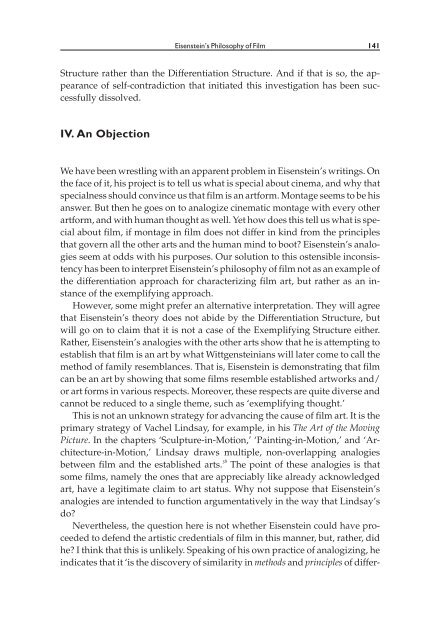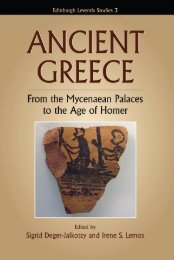Camera Obscura, Camera Lucida
Camera Obscura, Camera Lucida
Camera Obscura, Camera Lucida
You also want an ePaper? Increase the reach of your titles
YUMPU automatically turns print PDFs into web optimized ePapers that Google loves.
Structure rather than the Differentiation Structure. And if that is so, the appearance<br />
of self-contradiction that initiated this investigation has been successfully<br />
dissolved.<br />
IV. An Objection<br />
Eisenstein’s Philosophy of Film 141<br />
We have been wrestling with an apparent problem in Eisenstein’s writings. On<br />
the face of it, his project is to tell us what is special about cinema, and why that<br />
specialness should convince us that film is an artform. Montage seems to be his<br />
answer. But then he goes on to analogize cinematic montage with every other<br />
artform, and with human thought as well. Yet how does this tell us what is special<br />
about film, if montage in film does not differ in kind from the principles<br />
that govern all the other arts and the human mind to boot? Eisenstein’s analogies<br />
seem at odds with his purposes. Our solution to this ostensible inconsistency<br />
has been to interpret Eisenstein’s philosophy of film not as an example of<br />
the differentiation approach for characterizing film art, but rather as an instance<br />
of the exemplifying approach.<br />
However, some might prefer an alternative interpretation. They will agree<br />
that Eisenstein’s theory does not abide by the Differentiation Structure, but<br />
will go on to claim that it is not a case of the Exemplifying Structure either.<br />
Rather, Eisenstein’s analogies with the other arts show that he is attempting to<br />
establish that film is an art by what Wittgensteinians will later come to call the<br />
method of family resemblances. That is, Eisenstein is demonstrating that film<br />
can be an art by showing that some films resemble established artworks and/<br />
or art forms in various respects. Moreover, these respects are quite diverse and<br />
cannot be reduced to a single theme, such as ‘exemplifying thought.’<br />
This is not an unknown strategy for advancing the cause of film art. It is the<br />
primary strategy of Vachel Lindsay, for example, in his The Art of the Moving<br />
Picture. In the chapters ‘Sculpture-in-Motion,’ ‘Painting-in-Motion,’ and ‘Architecture-in-Motion,’<br />
Lindsay draws multiple, non-overlapping analogies<br />
between film and the established arts. 38 The point of these analogies is that<br />
some films, namely the ones that are appreciably like already acknowledged<br />
art, have a legitimate claim to art status. Why not suppose that Eisenstein’s<br />
analogies are intended to function argumentatively in the way that Lindsay’s<br />
do?<br />
Nevertheless, the question here is not whether Eisenstein could have proceeded<br />
to defend the artistic credentials of film in this manner, but, rather, did<br />
he? I think that this is unlikely. Speaking of his own practice of analogizing, he<br />
indicates that it ‘is the discovery of similarity in methods and principles of differ-






